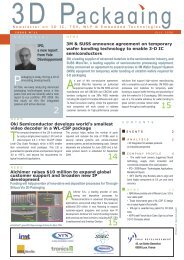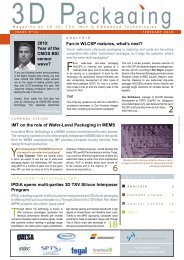September 2011 - I-Micronews
September 2011 - I-Micronews
September 2011 - I-Micronews
Create successful ePaper yourself
Turn your PDF publications into a flip-book with our unique Google optimized e-Paper software.
I S S U E N ° 1 3 S E P T E M B E R 2 0 1 1<br />
Inkjet has high potential for non-contact deposition<br />
of etchants, dopants and metals, though the process<br />
can be slow, and the fast-drying materials can easily<br />
clog the tiny nozzles to limit performance, presenting<br />
needs for new inks, new head designs and cleaning<br />
processes, and perhaps new solutions to recognize<br />
and correct print areas where blocked nozzles<br />
have impacted deposition quality. Lasers also have<br />
considerable potential for innovative improvements<br />
to solar manufacturing, as their highly-localized<br />
heating allows precise control of micromachining<br />
with little thermal stress or mechanical damage for<br />
fine geometry features on delicate thin wafers. Both<br />
inkjet and laser production processes are already<br />
well established in other high volume industries,<br />
which could accelerate the development of solar<br />
applications.<br />
Higher quality cells require purer,<br />
higher-performance materials, more<br />
controlled processes<br />
Improving solar efficiency will also require purer<br />
materials and more careful control of processes<br />
for contamination. As cell efficiency starts to get<br />
closer to theoretical limits, after 18% or so, eking<br />
out the next round of gains will mean paying<br />
more careful attention to the small stuff. The PV<br />
industry will need to evolve beyond its focus on<br />
high speed automation modeled on that of the<br />
automotive industry, to start to look more like the<br />
semiconductor industry - with its obsession with<br />
contamination control and process monitoring, and<br />
its practices of filter use, cleaning technologies, and<br />
keeping humans away from the processing. Gases,<br />
de-ionized water and other standard materials<br />
for PV production will all move to higher levels of<br />
purity and quality. On the cost reduction front,<br />
replacing silver metallization with copper could gain<br />
a significant advantage, but some reliability issues<br />
with corrosion and Cu migration into the silicon<br />
remain, necessitating additional buffer and capping<br />
steps that add back costs.<br />
Demand will move to higher purity<br />
polysilicon as well<br />
PV makers are increasingly demanding higher<br />
quality polysilicon as well, for higher efficiency cells.<br />
Yole Développement projects that demand will<br />
move to semiconductor grade material—9 nines to<br />
11 nines purity—essentially displacing solar-grade<br />
poly almost entirely in the market. With a backlog<br />
of solar module supply built up in inventory, and<br />
slowing demand from the cutbacks in government<br />
incentives, demand for poly this year looks likely<br />
to come in considerably below last year’s 160,000<br />
MT, leaving an oversupply in the sector. The four<br />
leading suppliers Wacker Chemie (Germany),<br />
Hemlock Semiconductor (Michigan, US), OCI<br />
(Korea) and GCL Poly (China), who are all providing<br />
semiconductor-grade material, together have enough<br />
P V M a n u f a c t u r i n g<br />
capacity among them to supply the entire PV<br />
industry demand this year. With no constraints<br />
on availability, it will be the higher purity material<br />
from these leading suppliers that sells, and enough<br />
demand for it to maintain poly prices stable at<br />
around $50/kg this year. Many of the new entrants<br />
who more recently added poly capacity have found<br />
it harder than expected to optimize this complex<br />
chemical process to match the leading pure-play<br />
players in quality and cost, and many will likely<br />
quietly get out of the business.<br />
HCPV efficiency could provide an edge,<br />
if sector and supply chain can scale to<br />
volume<br />
Long term trends towards efficiency could bode<br />
well for the future of HCPV, and this still barely<br />
commercial technology has wide margin to bring<br />
down costs if it moves to volume production. HCPV<br />
now reaches 29% efficiency at the module level at<br />
leading suppliers, compared to 17%-20% for the<br />
top flat panels, and it has even more of an edge in<br />
hot climates, as its performance degrades less at<br />
temperature.<br />
Plenty of hurdles remain, however, for this<br />
complicated new technology. Appropriately sunny<br />
locations remain limited, long term reliability remains<br />
unproven and actual commercial production so far<br />
remains insignificant. Though HCPV suppliers claim<br />
that the technology can deliver the lowest levelized<br />
cost of energy with the least use of land on some<br />
sites, the actual results can vary significantly for<br />
particular location, climate and topography, so even<br />
big users first want to try small test installations on<br />
their sites, and this small installation stage could<br />
continue for some time. Meanwhile, the large flat<br />
panel PV sector is continually investing its far bigger<br />
resources into improving its efficiency and bringing<br />
down its costs. While HCPV may have big potential<br />
with enough investment, with the market still so<br />
small, the sector has limited resources to put into<br />
development.<br />
The supply chain of key components on which<br />
HCPVsystems depend has even less to invest, as the<br />
total markets for each of the various components,<br />
from epi wafers to lenses to trackers, remain even<br />
smaller still. Progress will depend on getting to big<br />
projects to get volumes up to bring down costs,<br />
by spreading the fixed costs of the 25MW-50MW<br />
capacity HCPV plants over megawatt and not just<br />
kilowatt-scale projects, and fully automating both<br />
component production and system assembly - and<br />
finding the significant capital to invest to do so.<br />
Perhaps even more important will be finding the<br />
solutions for the most effective business models or<br />
working partnerships among the parts of the supply<br />
chain. As volumes grow, HCPV systems makers<br />
17<br />
“Lasers also have<br />
considerable<br />
potential for<br />
innovative<br />
improvements<br />
to solar<br />
manufacturing,<br />
as their highlylocalized<br />
heating<br />
allows precise<br />
control of<br />
micromachining<br />
with little<br />
thermal stress<br />
or mechanical<br />
damage,”<br />
says Milan Rosina,<br />
Yole Développement
















